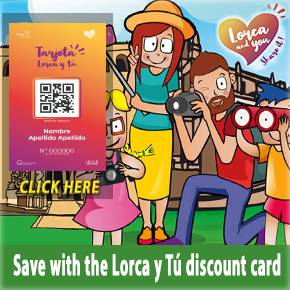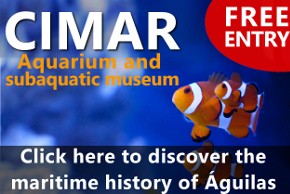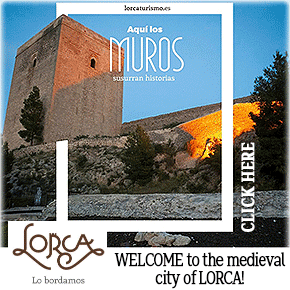June 13 to 15 Guided tour at Lorca castle, from the Bronze Age to the present day
Follow the timeline of human activity at the site of the Fortress of the Sun
 Lorca castle is of course immediately associated with the Middle Ages, particularly the period between the Reconquista of Murcia in the 13th century and the final expulsion of the Moors from Andalucía around 250 years later, but human activity at the location has been shown by archaeologists to date from far earlier.
Lorca castle is of course immediately associated with the Middle Ages, particularly the period between the Reconquista of Murcia in the 13th century and the final expulsion of the Moors from Andalucía around 250 years later, but human activity at the location has been shown by archaeologists to date from far earlier.
In fact, the hill on which the castle stands has been a favoured location for settlers since the Bronze Age, and between 13th and 15th June a series of guided visits are being held in which the timeline of human activity here is explained and illustrated. This coincides with the European Archaeology weekend, and it should be remembered that excavation at Lorca castle is still ongoing, particularly in the area of the remains of the 14th-century synagogue.
After the visit, those taking part are of course welcome to take a look at the synagogue, and the keeps of the Torre Alfonsina and the Torre del Espolón.
The three tours begin at 10.00 and registration, which is available online here, costs 7 euros (15 euros to access the three areas named above).
For more local information, including news and what’s on, go to the home page of Lorca Today.
Oficina de Turismo de Lorca

The rich and extensive history of Lorca has left a legacy of archaeological sites, and historic buildings, around which the modern City has built its tourism industry. Amongst these are Lorca Castle, the Jewish Quarter of the castle and Synagogue,  Plaza de España, Colegiata de San Patricio, Museo de Arqueologico Municipal, Iglesia de San Francisco, Casa Huerto Ruano, Palacio de Guevara, Iglesia de San Mateo, Pósito de los Panaderos, Convento Virgen de las Huertas, Antiguo Convento de la Merced, Iglesia del Carmen and the Teatro Guerra.
Plaza de España, Colegiata de San Patricio, Museo de Arqueologico Municipal, Iglesia de San Francisco, Casa Huerto Ruano, Palacio de Guevara, Iglesia de San Mateo, Pósito de los Panaderos, Convento Virgen de las Huertas, Antiguo Convento de la Merced, Iglesia del Carmen and the Teatro Guerra.
Unfortunately Lorca has also been prone to natural disaster, suffering a Gota Fría on September 28th 2012, as well as an earthquake which measured 5.3 on the Richter scale on 11th May 2011 and claimed 9 lives. Since this earthquake the city has been rebuilding, winning recognition for its Lorca, Open for Restoration initiative, which used the restoration of the city as a tourist attraction whilst it rebuilt its historical buildings, some of which are currently still not open.
 The tourist office itself has temporarily relocated until the renovations are completed and is on Calle San Patricio near the church.
The tourist office itself has temporarily relocated until the renovations are completed and is on Calle San Patricio near the church.
Lorca also has an area of coastline incorporating the Parque Regional de Cabo Cope - Puntas de Calnegre, in the Sierra de Almenara, which includes the beaches of, Puntas de Calnegre, Baño de las Mujeres, San  Pedro, El Siscal, Cala Honda, Cuartel del Ciscar, Junquera, Cala de la Gruta, Cala Leña, Los Hierros, Cala Blanca and Playa Larga, although many are accessible only through agricultural exploitations.
Pedro, El Siscal, Cala Honda, Cuartel del Ciscar, Junquera, Cala de la Gruta, Cala Leña, Los Hierros, Cala Blanca and Playa Larga, although many are accessible only through agricultural exploitations.
However, in spite of its many attractions, the name of Lorca is synonymous with Easter, (Semana Santa) its biblical parades of International Tourist Interest status and famous throughout Spain. The week includes a  series of parades in which the whites (Paso Blanco) and blues (Paso Azúl) try to outdo each other with the magnificence of their embroideries and the skill and daring of their horsemen.
series of parades in which the whites (Paso Blanco) and blues (Paso Azúl) try to outdo each other with the magnificence of their embroideries and the skill and daring of their horsemen.
Lorca also has a Parador hotel, located within the complex of its historic castle.
Opening hours for Lorca Tourist Office:
- Monday to Friday: 10.00 to 14.00 and 16.30 to 19.00.
- Saturday: 10.00 to 14.00 and 16.30 to 18.30.
- Sunday: 10.00 to 14.00.
For more local news, events and visiting information go to the home page of Lorca Today

































